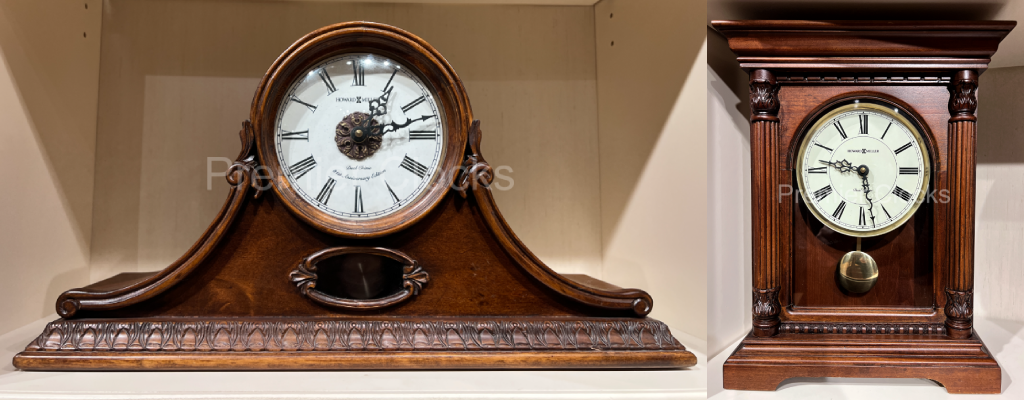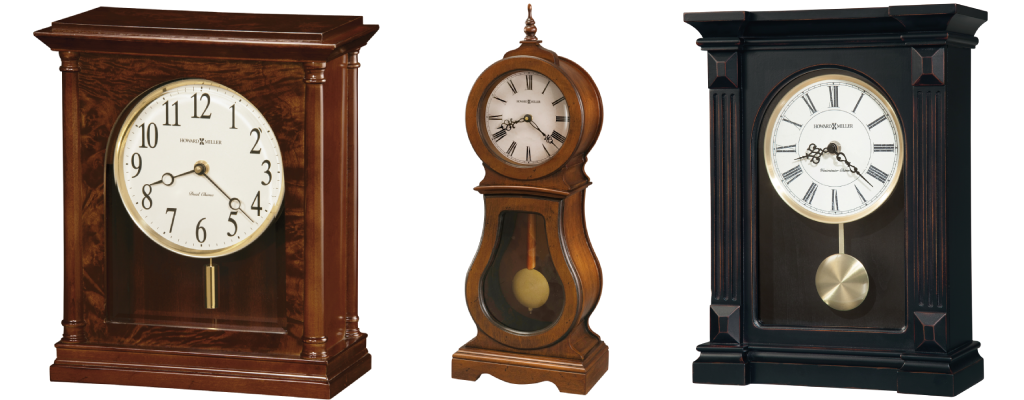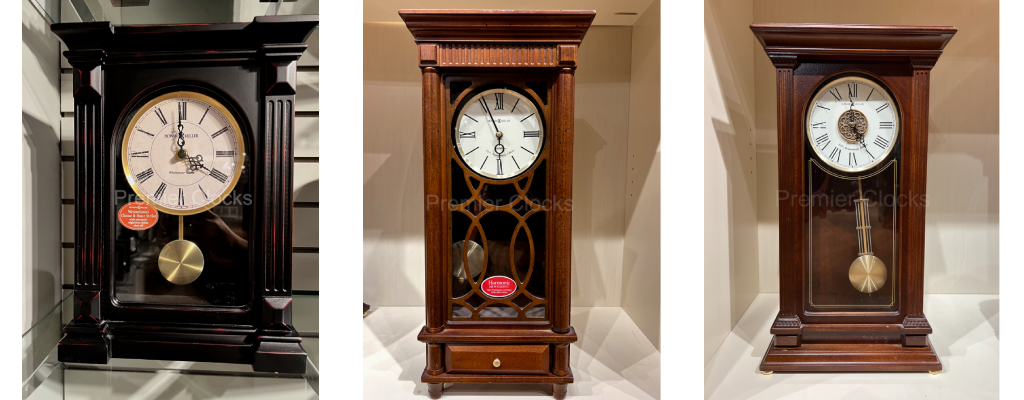In a world increasingly dominated by digital technology and smart devices, there is a quiet elegance and timeless charm found in the rhythmic swing of a pendulum of a mantel clock. Pendulum mantel clocks, often perched gracefully on mantelpieces, shelves, or tabletops, embody a fusion of mechanical precision and aesthetic beauty that has captivated generations. These exquisite timepieces have a rich history dating back centuries and have played a pivotal role in the evolution of timekeeping.
➤ Find your perfect Mantel Clock at Premier Clocks.
A pendulum mantel clock (sometimes called shelf clocks) is a classic mechanical clock designed to be displayed on a mantelpiece, shelf, or tabletop. It is characterized by its use of a pendulum mechanism to regulate and measure time. These clocks are known for their elegant and decorative appearance and have been popular for centuries.

Pendulum mantel clocks are known for their accurate timekeeping, largely due to the pendulum mechanism at their core.
At the heart of a pendulum mantel clock is the pendulum itself. It consists of a long, slender rod with a weight called a bob at the bottom. The pendulum swings back and forth in a precise and controlled manner. The key factors governing its operation are:
• Length: The length of the pendulum is crucial to its timekeeping accuracy. The longer the pendulum, the slower it swings, and vice versa. Clockmakers carefully adjust the pendulum's length to regulate the clock's accuracy.
• Isochronism: Pendulums have the unique property of isochronism, meaning that regardless of their amplitude (the distance they swing), they maintain a consistent period (the time it takes for one complete swing). This property ensures accurate timekeeping.
The escapement is a critical component of a pendulum mantel clock's movement. It controls the release of energy from the clock's mainspring (or weight-driven mechanism) to the gear train at precise intervals.
• Anchor: The anchor is a fork-like component with two pallets (teeth). It engages with the escape wheel, allowing it to advance one tooth at a time.
• Escape Wheel: The escape wheel has many teeth and is connected to the gear train. It receives energy from the mainspring and transfers it to the pendulum.
• Pallets: The pallets on the anchor interact with the teeth of the escape wheel. They briefly stop the escape wheel's motion during each swing of the pendulum, releasing a measured amount of energy with each swing.
The gear train is a series of gears and pinions that transmit the energy from the escapement to the clock's hands. It regulates the division of time into hours, minutes, and seconds. The gears and pinions are carefully designed to ensure accurate timekeeping.
Pendulum mantel clocks are powered either by a coiled mainspring or weights. In spring-driven clocks, winding the mainspring stores potential energy, which is gradually released to drive the clock's movement. In weight-driven clocks, weights are suspended from pulleys, and their descent provides the necessary energy.
The clock's hands, which indicate the hours, minutes, and sometimes seconds, are connected to the gear train. They move in a synchronized manner over a clock face or dial, allowing users to read the time.
➤ Learn more about Mantel Clocks at Premier Clocks Blog.
Pendulum mantel clocks have a rich history, and numerous clockmakers and brands have produced exceptional timepieces in this category.

Howard Miller is a well-known American clockmaker founded in 1926 and considered as one of the best clock brands. They are recognized for producing a wide range of clocks, including mantel clocks. Their clocks often feature high-quality craftsmanship, extra features, and various styles to suit different tastes. You can order mantel clocks at Premier Clocks. Click here for assistance and sale information.
Franz Hermle & Sons is a German clockmaker founded in 1922. They are renowned for their precision clock movements and have manufactured a variety of mantel clocks over the years.
Seth Thomas was a prominent American clockmaker who established his company in the early 19th century. Seth Thomas clocks, including mantel clocks, played a significant role in the development of the American clock industry.
Bulova is a well-established American watch and clock brand with a history dating back to the 19th century. They have produced mantel clocks with both classic and modern designs.
Seiko is a renowned Japanese brand known for its innovation in both wristwatches and clocks. They have created a variety of mantel clocks, often featuring precision quartz movements.
Kieninger is a German clockmaker founded in 1912. They are known for their high-quality mechanical movements and have produced a range of mantel clocks with traditional and contemporary designs.
These clockmakers and brands have made significant contributions to the world of mantel clocks, producing timepieces that range from traditional and antique styles to modern and contemporary designs. When selecting a pendulum mantel clock, consider your personal preferences and the overall decor of your space, as these clocks often serve as both functional timekeepers and decorative pieces.
➤ Read about Grandfather Clock Brands at Premier Clocks Blog.
Adjusting the pendulum on a mantel clock is a critical step in ensuring the clock keeps accurate time. Here's a general guide on how to adjust the pendulum on a mantel clock.

1. Check the Clock's Stability: Make sure the mantel clock is placed on a stable surface, such as a level mantelpiece or shelf. An uneven surface can affect the clock's timekeeping.
2. Inspect the Pendulum Length: Examine the pendulum's length. A longer pendulum will make the clock run more slowly, while a shorter one will make it run faster. To adjust the timekeeping, you may need to lengthen or shorten the pendulum.
3. Determine the Direction of Adjustment: If the clock is running too fast and you need to slow it down, you should lengthen the pendulum. If it's running too slow and you want to speed it up, you should shorten the pendulum.
4. Locate the Pendulum Adjustment Nut: Most mantel clocks have an adjustment nut on the bottom of the pendulum rod. This nut allows you to fine-tune the pendulum's length.
5. Adjusting the Pendulum:
• If you need to slow down the clock (it's running too fast), turn the adjustment nut clockwise (to the right). This will lengthen the pendulum slightly.
• If you need to speed up the clock (it's running too slow), turn the adjustment nut counterclockwise (to the left) to shorten the pendulum.
6. Make Gradual Adjustments: Make small, gradual adjustments to the pendulum length, and then observe the clock's timekeeping for a day or so. It may take some trial and error to achieve the desired accuracy. Avoid making large adjustments all at once, as this can lead to overcorrection.
7. Monitor the Clock's Performance: Keep an eye on the clock's performance over several days to ensure it is keeping accurate time. Adjust the pendulum as needed until the desired accuracy is achieved.
8. Level the Clock: In addition to adjusting the pendulum, make sure the mantel clock is level. Use a spirit level to ensure that the clock is not tilted in any direction. An unlevel clock can affect its operation.
9. Keep the Clock Wound: If your mantel clock is spring-driven, ensure that it is wound regularly according to the clock's instructions. Proper winding is essential for accurate timekeeping.
10. Regular Maintenance: Periodically check and adjust the pendulum as needed, as factors like temperature and humidity can affect the clock's performance.
➤ Find more information at the Mantel Clock Instruction Manual.
Remember that pendulum adjustment is a delicate process, and patience is key. It may take a few adjustments and some time to achieve the precise timekeeping you desire. If you find that you're having difficulty achieving accurate timekeeping, or if the clock still does not keep time correctly after adjustments, it may be necessary to consult a professional clockmaker for further inspection and maintenance.
Comments will be approved before showing up.
Sign up to get the latest on sales, new releases and more …